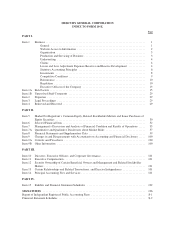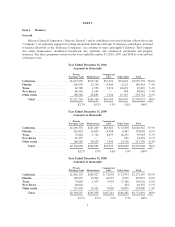Mercury Insurance 2010 Annual Report Download - page 20
Download and view the complete annual report
Please find page 20 of the 2010 Mercury Insurance annual report below. You can navigate through the pages in the report by either clicking on the pages listed below, or by using the keyword search tool below to find specific information within the annual report.Reputation for customer service and price are the principal means by which the Company competes with
other automobile insurers. In addition, the marketing efforts of independent agents and brokers can provide a
competitive advantage. Based on the most recent regularly published statistical compilations of premiums written
in 2010, the Company was the fifth largest writer of private passenger automobile insurance in California and the
twelfth largest in the United States.
The property and casualty insurance industry is highly cyclical, characterized by periods of high premium
rates and shortages of underwriting capacity (“hard market”) followed by periods of severe price competition and
excess capacity (“soft market”). In management’s view, 2004 through 2007 was a period of very profitable
results for companies underwriting automobile insurance. Many in the industry have experienced declining
profitability since 2007. Since 2009, many of the Company’s largest competitors increased rates on both private
passenger auto insurance and homeowners insurance. Rate increases generally indicate that the market is
hardening.
Reinsurance
The Company has reinsurance through the Florida Hurricane Catastrophe Trust Fund (“FHCF”) that
provides coverage equal to approximately 90 percent of $44 million in excess of $12 million per occurrence
based on the latest information provided by FHCF. The coverage is expected to change when new information is
available in March 2011.
For California homeowners policies, the Company has reduced its catastrophe exposure from earthquakes
by placing earthquake risks with the California Earthquake Authority (“CEA”). However, the Company
continues to have catastrophe exposure to fires following an earthquake. For more detailed discussion, see
“Regulation—Insurance Assessments.”
The Company carries a commercial umbrella reinsurance treaty and seeks facultative arrangements for large
property risks. In addition, the Company has other reinsurance in force that is not material to the consolidated
financial statements. If any reinsurers are unable to perform their obligations under a reinsurance treaty, the
Company will be required, as primary insurer, to discharge all obligations to its insured in their entirety.
Regulation
The Insurance Companies are subject to significant regulation and supervision by insurance departments of
the jurisdictions in which they are domiciled or licensed to operate business.
Department of Insurance Oversight
The powers of the DOI in each state primarily include the prior approval of insurance rates and rating
factors and the establishment of capital and surplus requirements, solvency standards, restrictions on dividend
payments and transactions with affiliates. DOI regulations and supervision are designed principally to benefit
policyholders rather than shareholders.
California Proposition 103 requires that property and casualty insurance rates be approved by the California
DOI prior to their use and that no rate be approved which is excessive, inadequate, unfairly discriminatory, or
otherwise in violation of the provisions of the initiative. The proposition specifies four statutory factors required
to be applied in “decreasing order of importance” in determining rates for private passenger automobile
insurance: (1) the insured’s driving safety record, (2) the number of miles the insured drives annually, (3) the
number of years of driving experience of the insured and (4) whatever optional factors are determined by the
California DOI to have a substantial relationship to risk of loss and are adopted by regulation. The statute further
provides that insurers are required to give at least a 20% discount to “good drivers,” as defined, from rates that
would otherwise be charged to such drivers and that no insurer may refuse to insure a “good driver.” The
Company’s rate plan was approved by the California DOI and operates under these rating factor regulations.
10
























